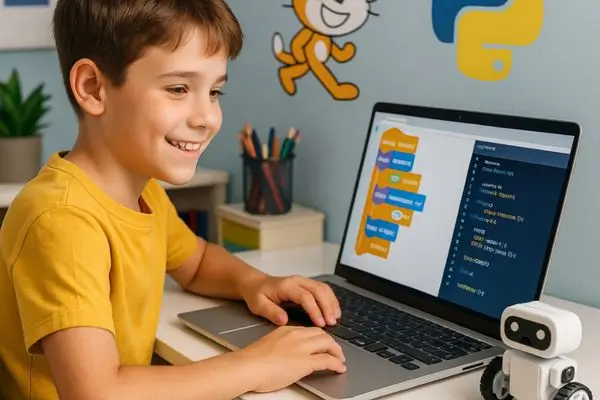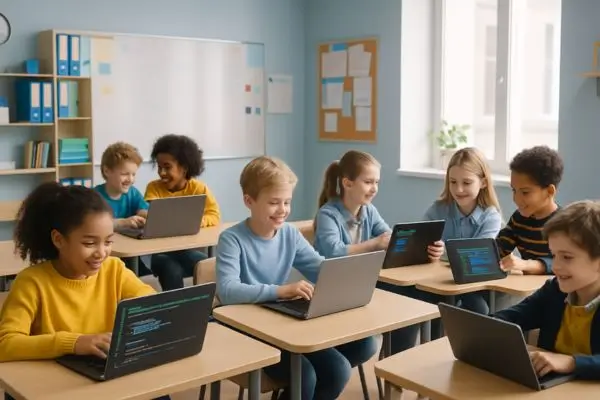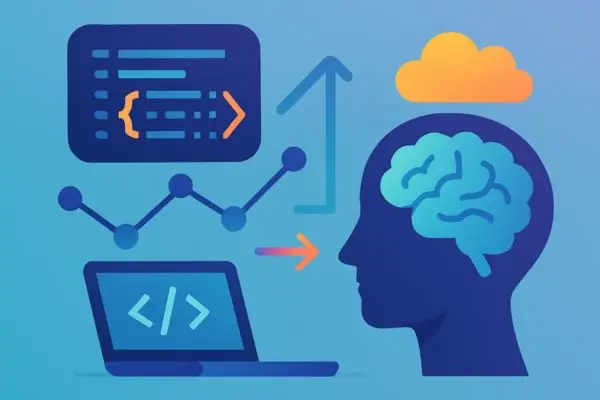Intro:
Computer Programming for 10-Year-Olds:
Have you ever wondered how your favorite games and apps are made? It’s all thanks to something called ‘coding’ or ‘computer programming.’ It might sound super technical and complex, but trust me, it’s a lot like solving puzzles or building with LEGOs. And guess what? Anyone, regardless of their background or experience, can learn it, even if you’re just starting!
Topics Covered
Table of Contents
This guide is designed to make coding an enjoyable and straightforward experience. We’ll walk you through it step by step, so you can start creating your cool stuff in no time: no complicated jargon, just plain talk and easy ideas. Let’s dive in!
See Also: Earn Passive Income with Crypto Trading: 7 Valuable Tips Unlocked
Why code Learning is enjoyable?
Think of coding as a superpower. It allows you to instruct computers precisely on what to do.
This means you can:
- Become a super problem-solver: Coding teaches you to break down big problems into smaller, more manageable pieces. This skill is super handy in school and life!
- Make useful tools: Maybe an app to help with homework or a website for your club.
- Build your own games: Just imagine designing characters, levels, and challenges. How cool is that?
- Boost your creativity: There are no limits to what you can imagine and build with code.
- Create incredible animations: Bring your drawings to life or tell interactive stories.
It’s not just about computers, either. Learning to code helps you think more clearly, be more patient, and even get better at math and science. It’s like a brain workout that’s actually fun!

Why Now is a Great Time to Start to learn code (Especially if You’re Around 10 years)
Some people think coding is only for grown-ups or super bright teenagers. But actually, if you’re around 10 years old, you’re in a perfect spot to start! Here’s why I’ll explain why:
• You’re ready for it: By this age, you’ve probably got a good handle on basic math and how to use a computer or tablet. This means you’re all set to understand the main ideas behind coding, like making things repeat or setting up rules.
•It builds excellent skills: When you code, you learn to solve problems step-by-step. If something doesn’t work, you figure out why and fix it. This makes you super persistent and good at figuring things out, which helps with everything from homework to everyday challenges.
• It’s super creative and fun: Coding lets you bring your ideas to life! Instead of just playing a game, you get to make one. You can design characters, tell stories, or create animations. It’s like having a magic wand for your computer. And when you share what you’ve made with friends, it’s a really incredible feeling!
Don’t worry about it feeling like schoolwork. The best way to learn coding is by playing and creating things you love, whether it’s robots, art, or your own favorite video games.
Picking Your First Coding Tools
Starting to code is like learning to ride a bike – you don’t jump straight onto a racing bike! You know. We’ll start with easy tools and then move to slightly more advanced ones.
Here are some great places to begin:
1. Block-Based Coding: Easy start
Imagine building with digital LEGOs. That’s what block-based coding is like! You drag and drop colorful blocks of code to make things happen. It’s perfect because you don’t have to worry about typing mistakes, and you can focus on the ideas.
• Scratch:
This is a favorite for many kids (and grown-ups!). It’s free and made by smart folks at MIT. With Scratch, you can easily make games and animations by snapping code blocks together. There’s a huge online community where you can see what others have made and even share your own projects.
• Blockly/Tynker:
These are similar to Scratch and are often used in fun, game-like lessons. They’re designed to be super kid-friendly and help you build confidence as you learn.
2. Simple Text Coding (Your Next Step!)
Once you’re comfortable with blocks, you might want to try writing code with words, just like grown-up programmers do! Don’t worry, we’ll start with an easy one.
•Python: This is a popular coding language that’s known for being easy to read, almost like regular English. You can use Python to make simple games, draw cool shapes, or even build small apps. It’s a great way to see that the ideas you learned with blocks are the same ones used in
all programming.
3. Game Engines (If You Love Video Games!)
If you’re a big fan of video games, why not learn to make your own? Some games have special tools that let you create your own levels, characters, and stories.
•Roblox Studio: If you play Roblox, you can use Roblox Studio to build your own games within Roblox. You’ll learn a bit of a language called Lua, which helps you make things move and interact.
•Minecraft Modding: Ever wanted to change how Minecraft works? You can! By learning to ‘mod’ Minecraft, you can add new items, creatures, or rules to the game. This often involves a bit of Java or simpler block editors.
These are super engaging because you’re building something you already love to play!
4. Robotics & Electronics (Code in the Real World!)
Want to see your code come to life outside the computer screen? Robotics is where it’s at! You can build robots and then tell them what to do with code.
Robotics Kits: Kits like LEGO Mindstorms or micro: bit let you build cool gadgets and then program them. You might start with block coding to make a car move, and then later use Python to control sensors. It’s a fantastic way to see how code affects the real world.

How to Learn: Online, Offline, and Everything In Between
Learning to code can happen in lots of different ways. The best approach combines online activities with hands-on experiences.
Free Online Fun:
There are tons of free websites where you can learn to code. They often have games and puzzles that teach you the basics.
- Code.org: Their ‘Hour of Code’ activities are super popular. You can learn coding with characters from Minecraft, Star Wars, or Angry Birds. It’s a quick and fun way to get started.
- Scratch (scratch.mit.edu): We talked about this one already! It’s free and has endless ideas for projects.
- Other cool sites: Khan Academy has intros to programming, and CodeCombat teaches you to code by playing a game. There are also lots of helpful videos on YouTube (just make sure a grown-up is around to help you find good ones).
These free tools let you learn at your own speed, right from your computer.
Classes and Camps (If You Need More Help):
Sometimes, it’s nice to have a teacher or a group of friends to learn with. There are classes and camps that can help.
- Online Coding Programs: Many places offer online classes where you work on projects. They often let you try a free lesson first to see if you like it.
- Local Camps and Clubs: Check if your school or local library has after-school coding clubs or summer camps. These are great for meeting other kids who love coding.
Having a teacher as a mentor can be really helpful in learning, especially if you get stuck. They can give you tips and help you understand tricky parts.
Learning Without a Screen (Yes, Really!):
Believe it or not, you can learn coding ideas even without a computer! These are called ‘unplugged’ activities.
•Board Games and Puzzles: Games that make you think logically, like mazes or certain board games, actually help you practice the kind of thinking you need for coding.
•Paper Coding: You can even write down instructions on paper for a friend or a toy robot to follow. This shows you that coding is all about giving clear, step-by-step directions.
These activities remind you that coding is mostly about thinking logically, even when you’re away from the computer.
Your Step-by-Step Plan to Becoming a Coding Whiz!
Ready to start your coding adventure? Here’s a simple roadmap to guide you:
Step 1: Start Super Simple with Blocks
Begin your journey with a visual, block-based tool like Scratch or Code.org. Don’t try to learn everything at once! Just focus on making something small and fun on your very first day. Maybe an animated character that moves across the screen, or a simple game where you click on something. The goal here is to have immediate fun and feel like a coding superstar right away. This builds your confidence and shows you how exciting coding can be.
Step 2: Make it Fun and About YOU!
Coding is way more fun when you’re working on something you actually care about. Do you love animals? Make a game about a cat chasing a mouse! Are you into art? Create an animation with your own drawings. If you’re interested in robots, find a project that lets you program a robot. When you connect coding to your hobbies and interests, you’ll stay motivated and excited to learn more.
Step 3: Build Projects, Not Just Lessons
Instead of just doing exercises, try to build small projects. For example, after a week or two, try to code a
“Choose Your Own Adventure” story in Scratch. A few weeks later, you could try making a simple quiz or a chatbot in Python. When you build projects, you learn how to put all the pieces together, and the concepts really stick in your head.
Step 4: Try Out Text Coding
Once you feel comfortable with block coding and have made a few projects, it’s time to dip your toes into text-based coding. Python is a great place to start. You can find online tools that let you type Python code right in your web browser. Keep your first scripts short and sweet. Maybe draw some shapes or print out some funny jokes. You’ll be surprised at how quickly you can pick it up, especially when you make it fun!
Step 5: Use Online Resources Wisely
There are tons of free tutorials and videos online, which is fantastic! But try to keep your learning sessions short and focused, maybe 15-30 minutes at a time. It’s better to learn a little bit every day than to try and cram everything in at once. Also, try to connect what you’re learning to things you see every day. For example, when you play a video game, think about how the programmers might have used code to make it work.
Step 6: Mix it Up!
Don’t spend all your time in front of a screen. Balance your coding time with other activities. If you’re really into tech, maybe get a robot-building kit or do a science experiment that’s related to code. This keeps things interesting and helps you understand the concepts on a deeper level.

Tips for Parents and Teachers
If you’re a grown-up helping a young coder, here are a few tips to make the journey smooth and fun:
1. Let them explore: It’s okay if things aren’t perfect. Let them play around with the code and be creative. Sometimes, a mistake can be a great learning opportunity!
2. Be patient and positive: Coding can be tricky at first. Praise their effort, not just their success. If they get stuck, ask questions to guide them instead of just giving them the answer.
3. Set a routine: Short, regular coding sessions are better than long, infrequent ones. Maybe 20 minutes, a few times a week.
4. Learn with them: You don’t have to be an expert! Learning alongside them can be a fun bonding experience.
5. Stay safe online: If they’re using online tools, remind them about online safety and not sharing personal information.
6. Connect it to school: Point out how coding is related to math, science, and even art. This helps them see the value in what they’re learning.
You’re Ready to Start Your Coding Adventure!
Coding is a fantastic skill that opens up a whole new world of creativity and problem-solving. By starting with simple, fun tools and building things you love, you can learn to code and create amazing things. So what are you waiting for? Go out there and start building your own games, animations, and apps. The only limit is your imagination!
See Also: AI Translator Rings Unleashed! Get 5 Stunning Devices to Conquer Language Barriers
Frequently Asked Questions (FAQs)
Here are some common questions you might have about starting your coding journey, answered simply:
1. Is coding really for everyone, even if I’m young or new to computers?
Absolutely! Coding is like solving puzzles or building with digital LEGOs, and anyone can learn it. The guide emphasizes that even young learners (around 10 years old) are in a great position to start because they often have a good grasp of basic math and computer use. It’s all about starting with simple tools and having fun!
2. Why should I bother learning to code? What are the benefits?
Learning to code gives you a superpower! You can build your own games, create awesome animations, and even make useful apps. Beyond that, it teaches you to break down big problems into smaller pieces, boosts your creativity, and helps you think more clearly. It’s a fun brain workout that can even improve your skills in math and science.
3. What’s the best way to start coding if I’m a beginner?
The best way to start is with
block-based coding tools like Scratch or Code.org. These tools let you drag and drop colorful code blocks, making it easy to understand the basic ideas without worrying about typing mistakes. Once you’re comfortable with blocks, you can try simple text-based languages like Python.
4. Do I need to spend money to learn how to code?
Not at all! There are tons of free online resources available. Websites like Code.org and Scratch offer fun, game-like lessons and endless project ideas. You can also find free tutorials and videos on platforms like Khan Academy and YouTube. While there are paid classes and camps if you want more structured help, you can definitely get started and learn a lot for free.
5. Is it all about screen time, or can I learn coding in other ways too?
It’s a mix! While computers are essential for writing code, you can also learn important coding ideas without a screen. Activities like logic puzzles, certain board games, or even
paper coding exercises (where you write instructions for someone else to follow) help you practice the logical thinking needed for coding. Balancing screen time with these ‘unplugged’ activities can make learning even more effective and fun.
Pingback: Programming Learning with AI Tools: A Beginner’s Guide to Smarter Coding | Entrepreneurs Break